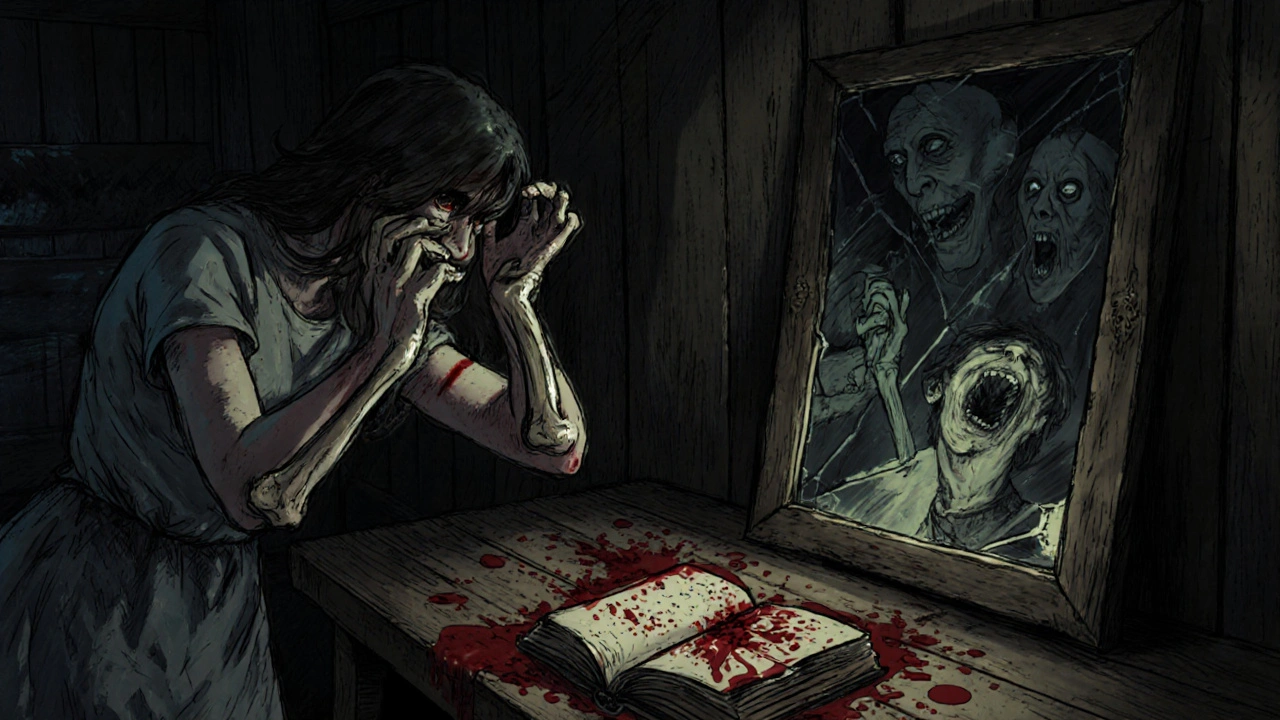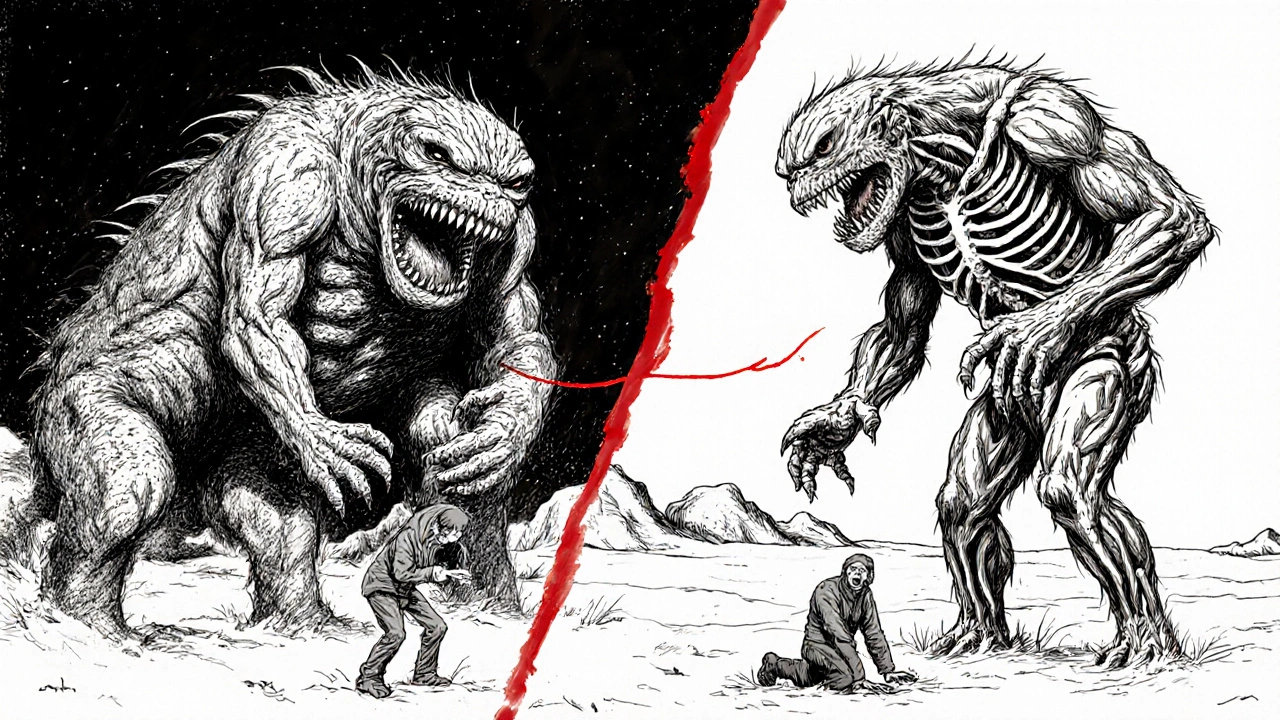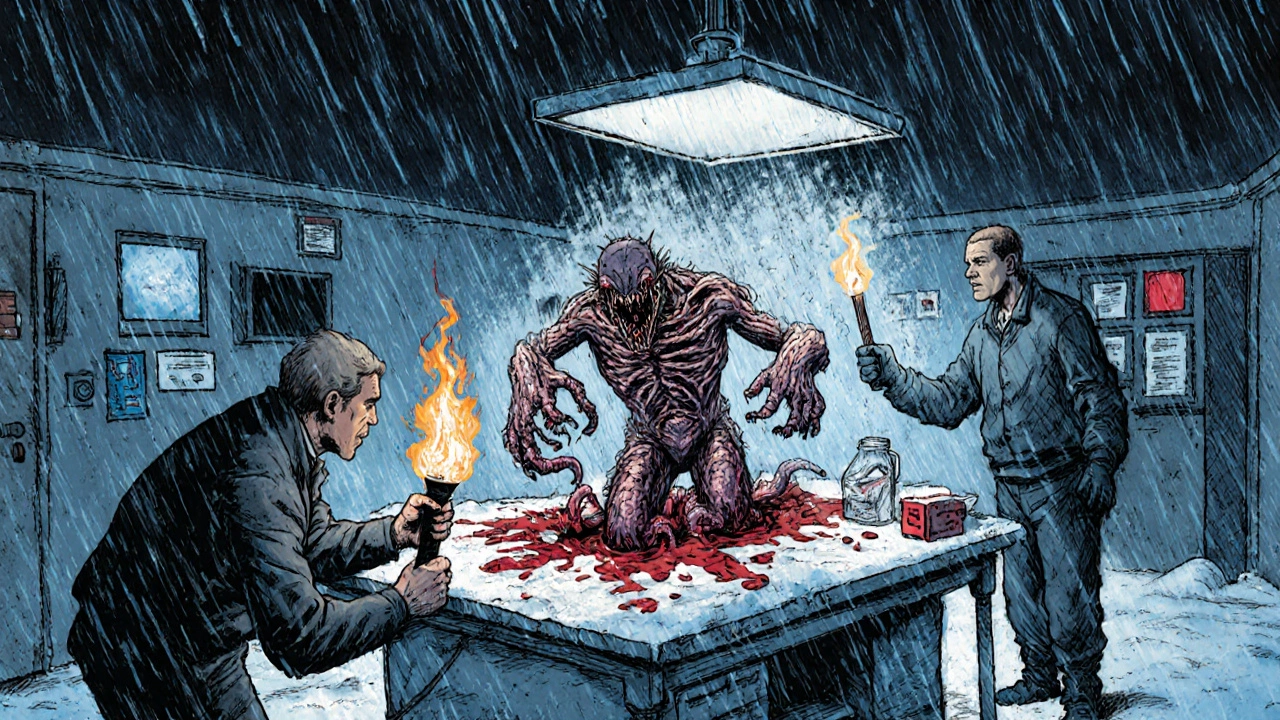Not every horror remake is a cash grab. Some actually make the original better. That’s rare. Most remakes strip away the tension, replace practical effects with CGI, and forget why the first version scared people in the first place. But a few? They don’t just copy-they rebuild. They take the fear that made the original iconic and turn it into something new, sharper, and just as chilling. Horror remakes that work don’t rely on nostalgia. They earn their place.
1982’s The Thing vs. 2011’s The Thing
The 1982 John Carpenter version of The Thing was a nightmare made of blood, paranoia, and rubber. It didn’t need jump scares. It made you distrust everyone on screen-even the dog. The 2011 prequel didn’t try to outdo it. It didn’t need to. Instead, it asked: What if you saw the monster before it became a full-blown nightmare? What if you watched it unfold, piece by piece, in a frozen Antarctic base with no way out?
The 2011 version, directed by Matthijs van Heijningen Jr., used practical effects just like the original. The creature design? Even more grotesque. The pacing? Slower, more methodical. The fear? More psychological. You don’t just watch the Thing transform-you feel the panic of scientists realizing their teammate is no longer human. The scene where the dog’s mouth splits open and a tentacle lashes out? Still gives me chills. It’s not a remake. It’s a prelude that makes the original even scarier.
The 2011 film didn’t get the box office it deserved. Critics called it too similar. But fans who rewatched it after the original? They knew the truth: it wasn’t copying. It was completing the story.
Evil Dead (2013): When Less Is More
The 1981 Evil Dead was a low-budget mess made with duct tape, a hand-cranked camera, and pure rage. Sam Raimi turned a $350,000 budget into a cult classic by filming like he was being chased. The 2013 version, directed by Fede Álvarez, didn’t try to be quirky or funny. It went full horror. No jokes. No Bruce Campbell. Just raw, unrelenting terror.
They removed the camp. They kept the cabin. They kept the Necronomicon. But now, the possession wasn’t cartoonish-it was visceral. The scenes where the protagonist’s hand starts moving on its own? That’s not a gag. That’s a violation. The dental scene? It’s not meant to be funny. It’s meant to make you look away. And you will.
The 2013 film used practical effects almost entirely. No green screen. No digital tricks. When someone gets ripped apart, you see the bones snap. When blood sprays, it’s real. The sound design? Every groan, every crack of bone, every wet tear-it’s designed to make your stomach turn. It’s the kind of horror that lingers because it feels real.
It didn’t replace the original. It showed what horror could be when you stop trying to be clever and start trying to be terrifying.

Why These Two Worked When Others Failed
Most remakes fail because they’re made by people who don’t understand the original. They think horror is about gore. Or loud music. Or cheap jump scares. But the best horror? It’s about control. Control over space. Control over time. Control over your own mind.
The Thing (2011) and Evil Dead (2013) both understood this. They didn’t remake the plot. They remade the feeling. They took the core emotion-the dread of being trapped, the fear of losing yourself-and rebuilt it with modern tools but the same soul.
Compare that to the 2018 Halloween remake. It copied the shots. It reused the music. But it didn’t capture the quiet dread of Michael Myers staring through a window. It turned him into a monster. The original made him feel like a shadow you couldn’t escape. The remake forgot that.
Successful remakes don’t copy. They translate. They take the language of the original and speak it in a new dialect. They respect the fear. They don’t exploit it.
What Makes a Horror Remake Worth Watching?
Here’s the rule: if the remake doesn’t make you feel something the original didn’t, why bother?
Ask yourself these questions before you press play:
- Does it add something new? A new setting? A new perspective? A deeper character?
- Does it use the original’s strengths-or just its name?
- Are the practical effects still real? Or is everything CGI and lifeless?
- Does the fear feel earned? Or is it just loud noises and flashing lights?
The 2011 The Thing answers yes to all four. The 2013 Evil Dead does too. Most others? They answer no.
Take the 2014 Poltergeist remake. It had a bigger budget. Better actors. Cleaner visuals. And yet, it felt hollow. Why? Because it didn’t understand that the original scared people because it made family feel unsafe. The remake made it feel like a haunted house tour. No soul. No stakes.

What’s Next? The Remakes That Could Work
There are horror remakes in development that might actually pull it off. A new Alien prequel? Maybe. A reimagining of The Shining from the perspective of the Overlook Hotel itself? That could be brilliant. A Creepshow anthology with modern stories? Absolutely.
But here’s the thing: the next great horror remake won’t be made by a studio chasing trends. It’ll be made by someone who loves the original so much they can’t stand to see it reduced to a meme. Someone who understands that horror isn’t about the monster-it’s about what the monster reveals about us.
That’s why The Thing and Evil Dead still work. They didn’t just update the visuals. They updated the truth.
Final Thought: The Real Horror Isn’t the Monster
The real horror in these remakes isn’t the creature. It’s the realization that you’re not safe anywhere. Not in a cabin. Not in a research station. Not even in your own skin. That’s what the originals taught us. And that’s what the best remakes remembered.
So if you’re looking for horror that actually matters, skip the sequels. Skip the franchises. Go back to the 2011 The Thing and the 2013 Evil Dead. Watch them back-to-back. Feel the dread. Then ask yourself: why do we keep making remakes? And why do only a few of them actually scare us?
Are horror remakes ever better than the originals?
Yes, but rarely. The 2011 version of The Thing and the 2013 version of Evil Dead are two of the few that actually improve on the originals-not by being flashier, but by deepening the fear. They respect the source material and add something new: more realism, more tension, and more psychological weight. Most remakes fail because they’re afraid to be different. These didn’t.
Why do most horror remakes fail?
They mistake nostalgia for substance. They copy the shots, reuse the music, and throw in CGI monsters, but they don’t understand what made the original scary. Horror works when it taps into real fears-loss of control, isolation, betrayal. Remakes that focus on spectacle over soul end up feeling empty. They’re haunted houses with no ghosts inside.
Is practical effects still important in modern horror?
Absolutely. CGI can look fake. Real blood, real rubber, real physical reactions? That’s what makes horror feel real. The 2013 Evil Dead used 90% practical effects. The 2011 The Thing did too. That’s why those scenes stick with you. When you see a hand tear through a chest, and it’s made of silicone and latex, your brain doesn’t know it’s not real. That’s the power of practical effects.
What’s the difference between a remake and a reboot?
A remake tries to retell the same story with updated tools. A reboot resets the universe-new characters, new rules, sometimes even a new genre. The 2013 Evil Dead is a remake: same cabin, same book, same possession. The 2023 Evil Dead Rise is a reboot: it’s set in a high-rise apartment, with new characters and a new kind of evil. Both can work, but only if they bring something new to the table.
Should I watch the originals before the remakes?
Not required, but it helps. Watching the 1982 The Thing first makes the 2011 version feel like a chilling prelude. Watching the 1981 Evil Dead makes the 2013 version feel like a brutal upgrade. The remakes are smarter when you know what they’re reacting to. But even without seeing the originals, the 2011 and 2013 versions stand strong on their own.

